Salix discolor (Pussy Willow)
| Also known as: | |
|---|---|
| Genus: | Salix |
| Family: | Salicaceae (Willow) |
| Life cycle: | perennial woody |
| Origin: | native |
| Habitat: | sun; moist to wet; swamps, marshes, shores, thickets, seeps, swales, wet meadows, wet ditches |
| Bloom season: | April - May |
| Plant height: | 6 to 30 feet |
| Wetland Indicator Status: | GP: FACW MW: FACW NCNE: FACW |
| MN county distribution (click map to enlarge): |  |
| National distribution (click map to enlarge): |  |
Pick an image for a larger view. See the glossary for icon descriptions.
Detailed Information
Flower: 

![[photo of male catkins]](/udata/r9ndp23q/pd3/salix-discolor-7953-10-t.jpg) Male and female flowers are on separate plants (dioecious) in spike-like clusters (catkins) at the tips of very short branchlets or from buds along 1 year old branches, emerging before the leaves. Male catkins are 1 to 2 inches long, the flowers densely to somewhat loosely packed, each flower with 2 yellow-tipped stamens.
Male and female flowers are on separate plants (dioecious) in spike-like clusters (catkins) at the tips of very short branchlets or from buds along 1 year old branches, emerging before the leaves. Male catkins are 1 to 2 inches long, the flowers densely to somewhat loosely packed, each flower with 2 yellow-tipped stamens.
![[photo of female catkins]](/udata/r9ndp23q/pd3/salix-discolor-12-7-t.jpg) Female catkins are 1 to 4+ inches long, the flowers crowded on the spike, bulbous at the base with a long beak, covered in fine hairs, and on slender stalks 2 to 3 mm (to 1/8 inch) long. At the base of each male and female flower stalk is a tiny, dark brown to blackish, scale-like bract densely covered in long, straight hairs.
Female catkins are 1 to 4+ inches long, the flowers crowded on the spike, bulbous at the base with a long beak, covered in fine hairs, and on slender stalks 2 to 3 mm (to 1/8 inch) long. At the base of each male and female flower stalk is a tiny, dark brown to blackish, scale-like bract densely covered in long, straight hairs.
Leaves and stems: 

![[photo of leaves]](/udata/r9ndp23q/pd3/salix-discolor-15-3-t.jpg) Leaves are alternate, 1 to 3+ inches long, up to 1 3/8 inch wide, 2.5 to 4 times as long as wide, elliptic to narrowly urn-shaped, widest at or above the middle or near the tip, pointed at the tip, wedge-shaped to somewhat rounded at the base, irregularly toothed around the edges often with shallow, rounded teeth, sometimes toothless. The upper surface is medium to dark green, the lower surface pale green to nearly white.
Leaves are alternate, 1 to 3+ inches long, up to 1 3/8 inch wide, 2.5 to 4 times as long as wide, elliptic to narrowly urn-shaped, widest at or above the middle or near the tip, pointed at the tip, wedge-shaped to somewhat rounded at the base, irregularly toothed around the edges often with shallow, rounded teeth, sometimes toothless. The upper surface is medium to dark green, the lower surface pale green to nearly white.
![[photo of hairy twig and stipules]](/udata/r9ndp23q/pd3/salix-discolor-15-5-t.jpg) At the base of the leaf stalk is a pair of small, leaf-like appendages (stipules) that are pointed at the tip, but are absent or obscure on early leaves. New leaves are moderately covered in white and/or rust-colored hairs on one or both surfaces and are often red-tinged, usually becoming hairless with age. The main veins are mostly curved upward from the midvein and irregularly spaced. New branchlets are short-hairy and green, becoming dark reddish-brown or yellowish-brown and hairless the second year.
At the base of the leaf stalk is a pair of small, leaf-like appendages (stipules) that are pointed at the tip, but are absent or obscure on early leaves. New leaves are moderately covered in white and/or rust-colored hairs on one or both surfaces and are often red-tinged, usually becoming hairless with age. The main veins are mostly curved upward from the midvein and irregularly spaced. New branchlets are short-hairy and green, becoming dark reddish-brown or yellowish-brown and hairless the second year.
![[photo of lower stems]](/udata/r9ndp23q/trees/salix-discolor-pussy-willow_0504_123146-t.jpg) Stems have smooth to slightly rough, gray bark, with multiple branches arising from the base. Older, mature trunks develop furrowed, gray bark and can reach 8+ inches diameter.
Stems have smooth to slightly rough, gray bark, with multiple branches arising from the base. Older, mature trunks develop furrowed, gray bark and can reach 8+ inches diameter.
Fruit: 
![[photo of developing fruit]](/udata/r9ndp23q/pd3/salix-discolor-14-2-t.jpg) The spike elongates some as fruit matures, the fruit becoming more loosely arranged than the flowers. Fruit is a capsule 6 to 11 mm long, yellowish when mature, covered in short hairs, inflated at the base with a long, slender beak. The capsule splits into two halves when mature, releasing the cottony seed; this happens before leaves are fully mature.
The spike elongates some as fruit matures, the fruit becoming more loosely arranged than the flowers. Fruit is a capsule 6 to 11 mm long, yellowish when mature, covered in short hairs, inflated at the base with a long, slender beak. The capsule splits into two halves when mature, releasing the cottony seed; this happens before leaves are fully mature.
Notes:
There are over 20 species of Willows in Minnesota; Pussy Willow is one of several common species and is typically a large, multi-stemmed shrub, sometimes taking the form of a single-stemmed tree up to 30 feet tall. It is found in a variety of moist to wet places including lake and pond margins, swamps, wet meadows and wet ditches, often with other Willow species. It is one of the earliest spring bloomers and an important food source for emerging bees. It is a variable species but might be recognized by the early bloom period; relatively large fruiting catkins with the leaves not emerging until flowers are well past peak; leaves widest at or above the middle, usually hairy when young and hairless at maturity, the main veins curving up from the midvein, unevenly spaced and minor veins more obscure; first year twigs green and hairy turning brown to red-brown the second year; male flowers have 2 stamens. Both male and female flowers are subtended by a tiny, blackish bract covered in long, straight, white hairs.
The leaves most closely resemble those of Diamond-leaf Willow (Salix planifolia), which has similar venation but the main veins are somewhat straighter, more numerous and evenly spaced, fruit is smaller (to 6mm long) and densely covered in appressed silky hairs, leaves are shinier on the upper surface and twigs are also shiny and reddish. Prairie Willow (Salix humilis) also has similarly shaped leaves, but are more consistently hairy on the lower surface, the fruiting catkins are shorter and more compact, and it prefers drier, upland habitats though is sometimes found along shores, river banks or wetland edges.
Salix discolor has been known to hybridize with several other willows; only one hybrid occurrence (with S. candida) has ever been recorded in Minnesota, from a Minneapolis park in 1915, so such cases are rare here. Coincidentally(?), the single recorded hybrid occurrence of Salix bebbiana x petiolaris was on the same day at the same park.
Native Plant Nurseries, Restoration and Landscaping Services ↓
More photos
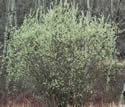 female Pussy Willow in full bloom
female Pussy Willow in full bloom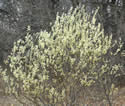 male Pussy Willow in full bloom
male Pussy Willow in full bloom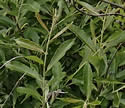 Pussy Willow on the north shore of Lake Superior
Pussy Willow on the north shore of Lake Superior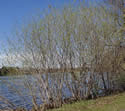 Pussy Willow just past flowering
Pussy Willow just past flowering Pussy Willow as a small tree
Pussy Willow as a small tree new leaves are tinged red
new leaves are tinged red leaf underside is pale and hairless with few pronounced veins
leaf underside is pale and hairless with few pronounced veins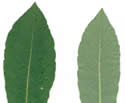 leaf scan
leaf scan maturing fruit with its bract
maturing fruit with its bract breaking bud in early spring
breaking bud in early spring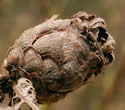 midge galls resemble pine cones
midge galls resemble pine cones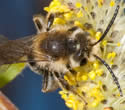 pollinator: Andrena on Pussy Willow
pollinator: Andrena on Pussy Willow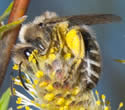 pollinator: Colletes on Pussy Willow
pollinator: Colletes on Pussy Willow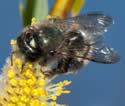 pollinator: Osmia on Pussy Willow
pollinator: Osmia on Pussy Willow comparison of Salix discolor and S. planifolia vein pattern
comparison of Salix discolor and S. planifolia vein pattern
Photos by K. Chayka taken in Ramsey County. Photos by Peter M. Dziuk taken in Anoka, Cook and Ramsey counties. Pollinator photos courtesy Heather Holm.
Comments
Have you seen this plant in Minnesota, or have any other comments about it?
on: 2020-04-02 09:39:35
Just discovered my first pussy willow yesterday as walking around my woods looking for pine seedlings that survived the winter. Pretty excited because I don't think I've seen them in a natural setting before.
on: 2020-04-26 09:32:09
Saw a pussy Willow tree along Paul Bunyan bike trail about 8 miles N of Pine River. Cool little buds bursting out and bees all over them! We took a picture.
on: 2024-03-14 20:35:29
Walking along a dirt road in woods near town of Askov during sunset and I noticed all the beautiful reddish green shoots of willow coming to life in the ditches. As I examined closer I noticed all the furry little grayish white buds appearing!! What an exclaim of delight I had because I did not realize they were actually pussy willows!! How beautiful, as I haven't seen them in the wild since I was a little girl in Illinois. Spring is early this year as it is only March 14 and I read they normally bloom in April. What a joy and how I love the beauty of the state of Minnesota. ❤️






